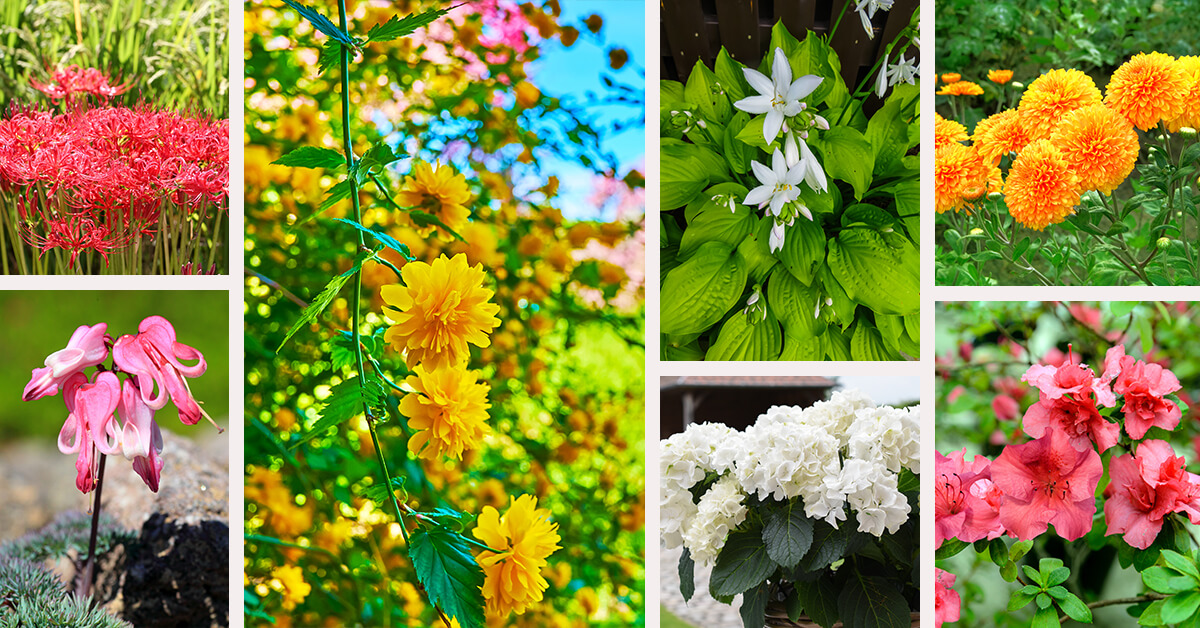The best Japanese flowers will fill your space with balance, beauty, and elegance. Designed correctly, a Japanese-inspired garden can soothe away stress and offer a sanctuary for the weary spirit. Combine the feeling of balance as well as the concept of wabi-sabi to unlock this sought-after ambiance. To achieve balance, temper intense colors with delicate hues.
The Top 27 Japanese Flowers to Plant in Your Garden for Balance and Beauty

Contrast simple, sleek flowers with blooms that are fanciful and sculptural. Wabi-sabi is a little more complicated, but, in essence, means finding beauty in the imperfect. Which types of Japanese flowers can help you achieve tranquility depends on your botanical style and your space.
1. Camellia (Camellia Japonica ‘April Dawn’)
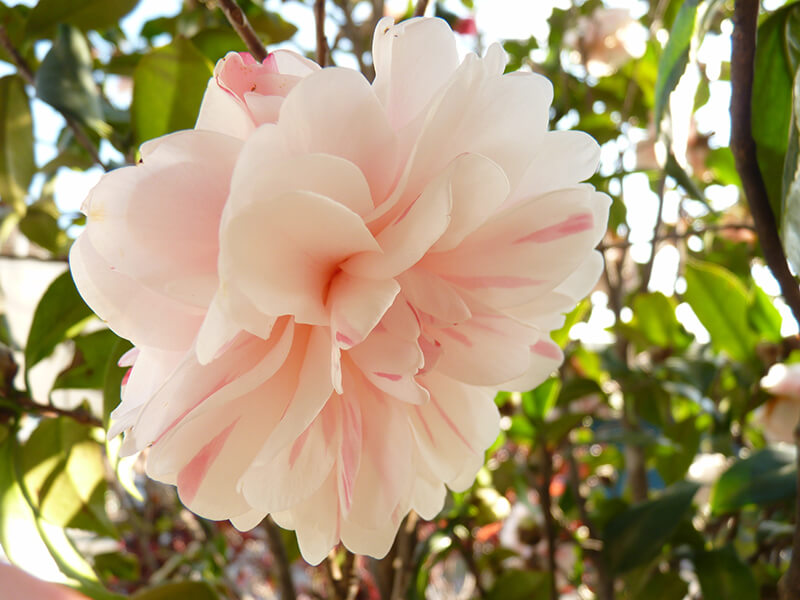
- 🔮 Symbolism: Steadfast love, good luck, aristocracy
- 💧 Water needs: Medium
- 🪴 Soil needs: Acidic, well-drained soil
- 🌍 Growing zones: 6 to 9
- ☀️ Light needs: Part shade
- 🌱 Blooming season: April
Originally from Japan and East Asia, camellias offer a wide variety of colors and flower shapes. With artistic elegance, this variety of camellia features soft pink streaks on a cool white background. Because it also offers more robust winter hardiness than most camellia varieties, ‘April Dawn’ is a great choice for those who live in colder climates.
2. Sword-Leaved Iris (Iris Ensata)
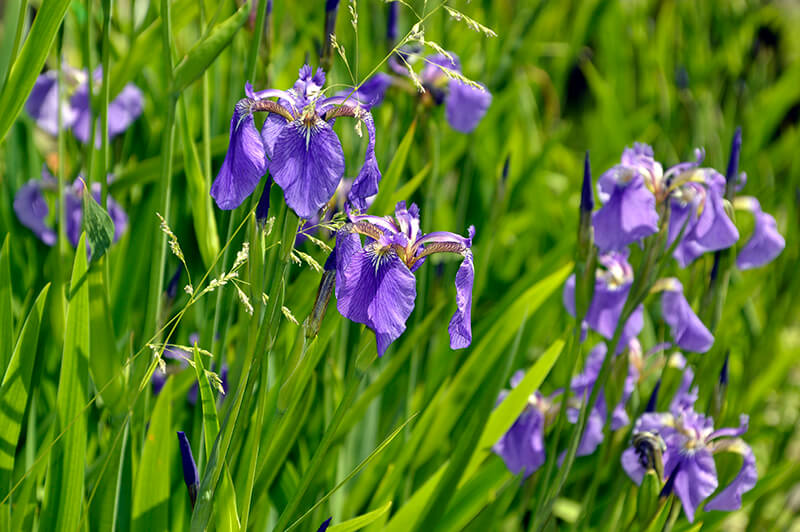
- 🔮 Symbolism: Strength, victory
- 💧 Water needs: Medium to wet
- 🪴 Soil needs: Acidic, poorly draining soil, tolerates standing water
- 🌍 Growing zones: 4 to 9
- ☀️ Light needs: Full Sun to part shade
- 🌱 Blooming season: June to July
Often seen near water, a sword-leaved iris loves to be planted in boggy soils. Although the flower in this image is a warm purple with yellow accents, it can be found in a wide variety of colors and forms. If you are looking for ways to bring pictures of Japanese flowers to life for the ideal Japanese garden, include a sword-leaved iris or three near your water feature.
3. Yamabuki Japanese Rose (Kerria Japonica ‘Pleniflora’)
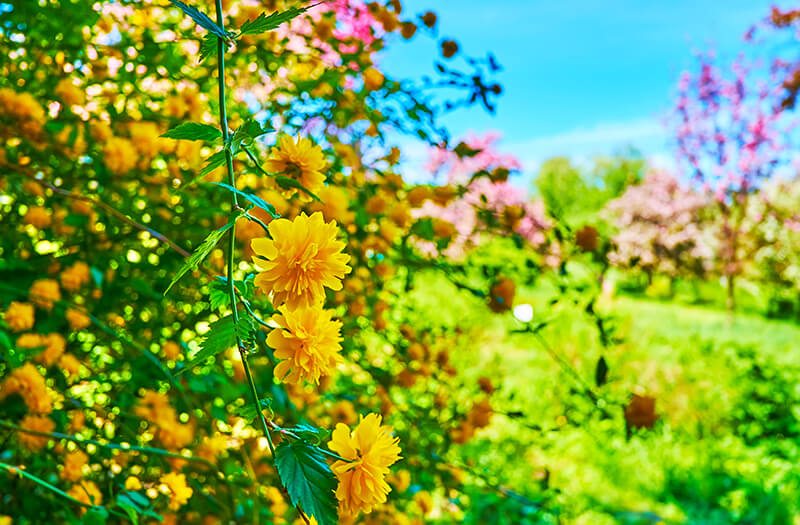
- 🔮 Symbolism: Second chances
- 💧 Water needs: Medium
- 🪴 Soil needs: Average, well-drained soil, avoid clay soils
- 🌍 Growing zones: 4 to 9
- ☀️ Light needs: Part shade
- 🌱 Blooming season: April to May
Originating on mountainsides, the Japanese rose, called Yamabuki in Japan, is the perfect balance between elegance and hardiness. With fluffy 2-inch blooms shaped like pom-poms, these flowers add a joyful springtime sparkle to any landscape. While the leaves turn yellow in fall, the stems remain green to provide colorful winter interest for your garden.
4. Lily of the Valley Bush (Pieris Japonica ‘Shojo’)

- 🔮 Symbolism: Return of happiness
- 💧 Water needs: Medium
- 🪴 Soil needs: Rich, mildly acidic, well-draining soil
- 🌍 Growing zones: 5 to 8
- ☀️ Light needs: Full sun – part shade
- 🌱 Blooming season: April
When fully emerged, these bell-shaped blossoms are a luxurious pink. However, the show starts in early spring when dark red flower buds begin to form. Because the leaves are evergreen, the lily of the valley bush brings a bright splash of color to your garden no matter what the season.
5. Komakusa Bleeding Heart (Dicentra Peregrina)
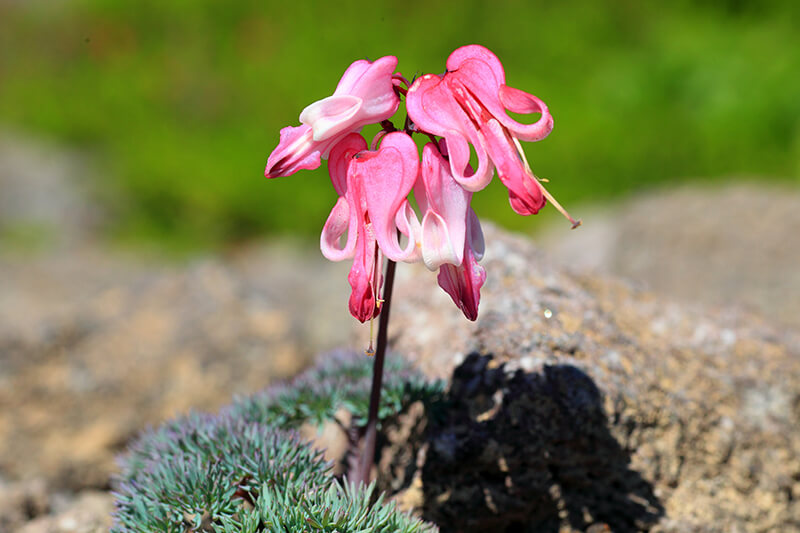
- 🔮 Symbolism: Faithful love
- 💧 Water needs: Medium
- 🪴 Soil needs: Average, well-draining soil
- 🌍 Growing zones: 3 to 7
- ☀️ Light needs: Full Sun to part shade
- 🌱 Blooming season: April to June
As a Japanese variety of bleeding hearts, Komakusa features the heart-shaped flowers you love with an equine twist. Do you see the stylized horse’s head in the images of these Japanese flowers? Its sculptural shape and vibrant color mean that it will add a splash of romantic drama to any garden.
6. Shirouma Asatsuki Chives (Allium Schoenoprasum)
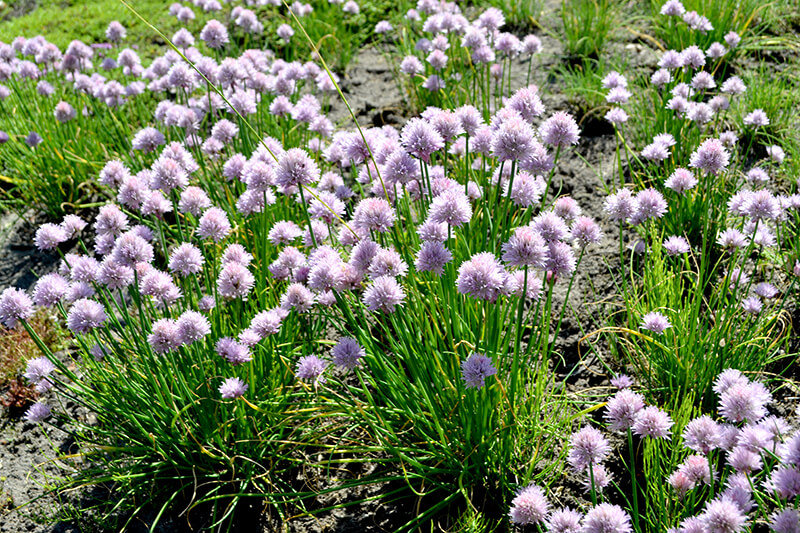
- 🔮 Symbolism: Stay true to yourself
- 💧 Water needs: Medium
- 🪴 Soil needs: Porous, well-draining soil
- 🌍 Growing zones: 4 to 8
- ☀️ Light needs: Full sun to part shade
- 🌱 Blooming season: April to May
Although you might not think of chives as a Japanese flower, these fun spherical flowers can be found throughout the Japanese Alps. As an ornamental accent, shirouma asatsuki provides a pleasurable cloud of purple puffs in the spring. Imagine how well the round shape and lavender color will pair with your Easter decor.
7. Sacred Lotus (Nelumbo Nucifera ‘Pekinensis Rubra’)

- 🔮 Symbolism: Wisdom, truth, and time
- 💧 Water needs: Aquatic
- 🪴 Soil needs: Submerged, rich soil
- 🌍 Growing zones: 4 to 10
- ☀️ Light needs: Full sun
- 🌱 Blooming season: July to September
A few sacred lotus flowers can help a water feature feel balanced as well as beautiful. Soak in the flowers’ elegance through the summer and fall. After the flowers fade, papery brown seed pods make these some of the best Japanese flowers to plant if you love creating your own floral arrangements. This variety features delicate pink-tipped flowers.
8. Kinmokusei Fragrant Tea Olive (Osmanthus Fragrans f. Aurantiacus ‘Orange Supreme’)
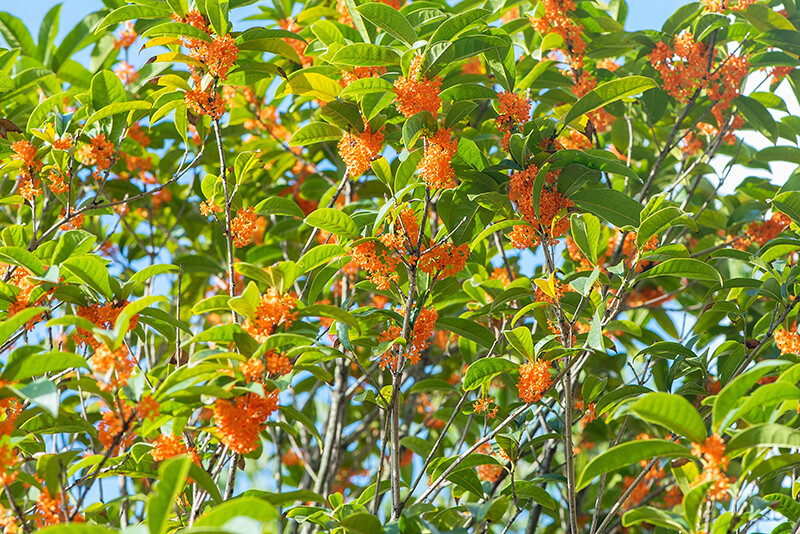
- 🔮 Symbolism: Heritage and memory
- 💧 Water needs: Medium, drought tolerant
- 🪴 Soil needs: Consistently moist, well-draining soil, tolerates clay-type soils
- 🌍 Growing zones: 8 to 11
- ☀️ Light needs: Full sun to part shade
- 🌱 Blooming season: April
Because they are known for an ambrosial apricot fragrance, images of these Japanese flowers simply do not capture their full potential. For an immersive experience that entices all the senses, invite this aromatic orange flower into your garden design. By using different pruning techniques, you can shape this broadleaf evergreen to be a showy espalier, tidy shrub, or small tree.
9. Toad Lily (Tricyrtis Hirta ‘Miyazaki’)

- 🔮 Symbolism: Good luck
- 💧 Water needs: Medium to wet
- 🪴 Soil needs: Average, well-draining soil
- 🌍 Growing zones: 4 to 8
- ☀️ Light needs: Part shade to full shade
- 🌱 Blooming season: August to September
If you have a shady part of your garden that never dries out, toad lilies are a fantastic option to add some eye-catching color. Pictures of these Japanese flowers showcase their dramatic spots and origami-like design. To achieve balance, pair the ostentatious toad lilies with plants that offer simple elegance.
10. Yabu Ran Lily Turf (Liriope Muscari ‘Okina’)
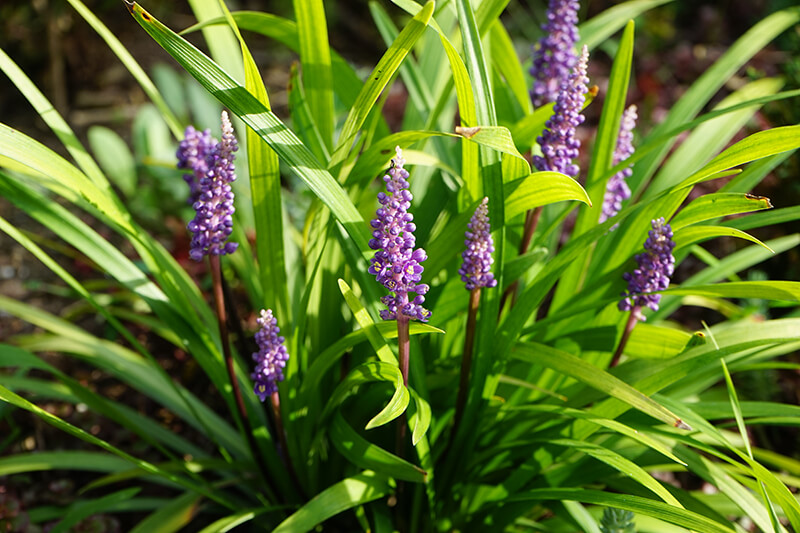
- 🔮 Symbolism: Playfulness
- 💧 Water needs: Medium, tolerates drought
- 🪴 Soil needs: Average, well-draining soil preferred, tolerates a wide range of soil types
- 🌍 Growing zones: 5 to 10
- ☀️ Light needs: Full sun to part shade
- 🌱 Blooming season: August to September
Floppy flowers soften a space and add romance to your landscape, but, without contrast, can feel saccharine. Energizing purple spikes emerge from tufts of vibrant green grass-like clumps to cultivate dimension. This variety of lily turf begins the season with startling yet attractive white foliage that slowly becomes bright green.
11. Tama Kanzashi Hosta (Hosta Plantaginea var. Japonica)
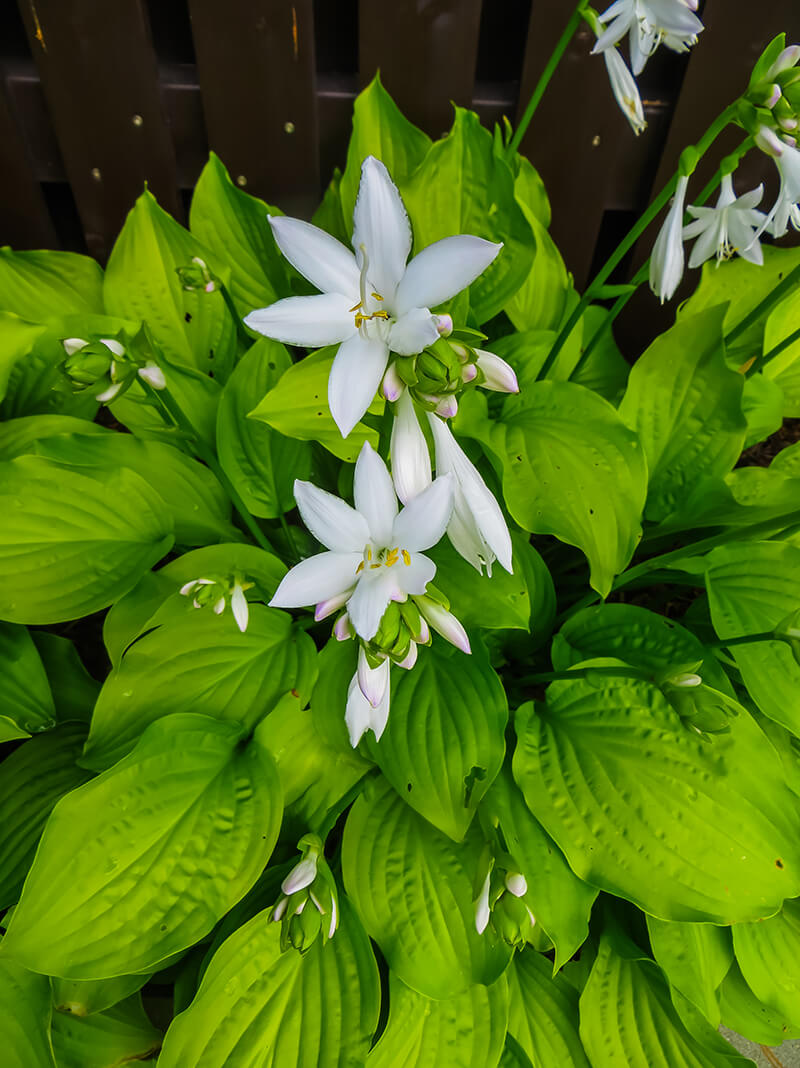
- 🔮 Symbolism: Treasure
- 💧 Water needs: Medium
- 🪴 Soil needs: Average, well-draining soil, tolerates a wide range of soil types
- 🌍 Growing zones: 3 to 9
- ☀️ Light needs: Part shade to full shade
- 🌱 Blooming season: August to September
In Japan, this variety of hosta is known as “tama kanzashi,” or “jewel of the hairpiece.” When you see pictures of these Japanese flowers, it is easy to see why. Each plant is capable of producing a five-foot-tall spathe filled with sleek white blossoms. Best of all, it requires little maintenance which makes it the perfect plant for those just beginning their gardening journey.
12. Nadeshiko Carnation (Dianthus Superbus)
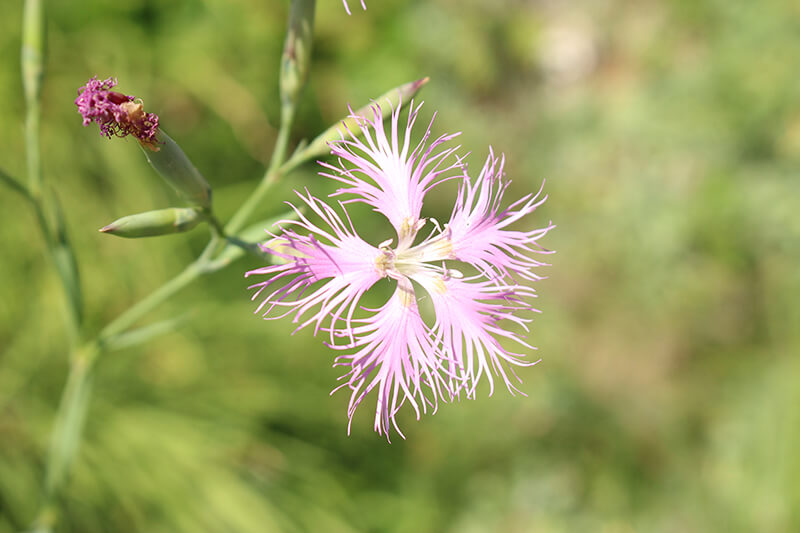
- 🔮 Symbolism: Motherhood
- 💧 Water needs: Medium
- 🪴 Soil needs: Slightly alkaline, gritty loam-type soil
- 🌍 Growing zones: 3 to 8
- ☀️ Light needs: Full sun
- 🌱 Blooming season: June to July
Full of frilled extravagance, these carnations are the perfect counterpoint to a garden filled with sleek silhouettes. Each lacy flower is a cool pink hue and stands 12 inches from the ground. To make a statement, plant your nadeshiko carnations in front of taller plants with simple foliage. They can also be planted in rock gardens to great effect.
13. Hotaru Bukuro Spotted Bellflower (Campanula Punctata ‘Cherry Bells’)
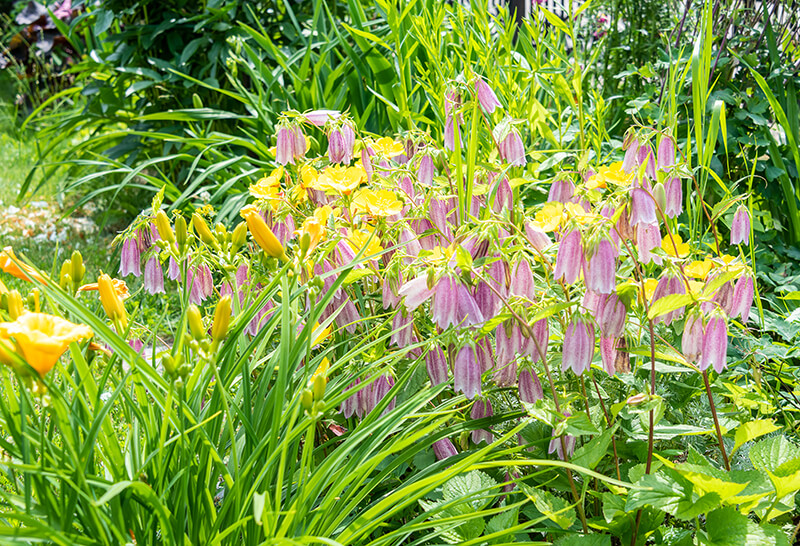
- 🔮 Symbolism: Illumination
- 💧 Water needs: Medium
- 🪴 Soil needs: Consistently moist, well-drained soil
- 🌍 Growing zones: 5 to 7
- ☀️ Light needs: Full sun to part shade
- 🌱 Blooming season: June to July
In Japan, fireflies enter the tubular bellflowers and illuminate them to enchanting effect. This is where the name “hotaru bukuro” meaning “firefly bag” originates. With vibrant cherry-pink blossoms, this variety of spotted bellflower arrives ready to party. At first glance, these flowers may seem simple, but closer inspection reveals a nuanced speckling.
14. Chrysanthemum (Chrysanthemum)
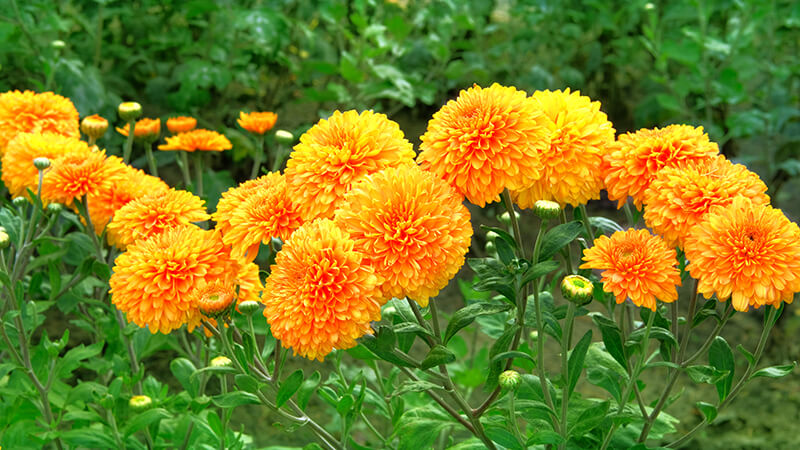
- 🔮 Symbolism: Rejuvenation, immortality
- 💧 Water needs: Medium
- 🪴 Soil needs: Fertile, Well-draining soil
- 🌍 Growing zones: 4 to 8
- ☀️ Light needs: Full sun
- 🌱 Blooming season: September until Frost
Chrysanthemums offer it all: vivacious color, intricate flower shape, a long blooming season, and legendary hardiness. Although they are available in a wide variety of colors, yellow flowers such as the chrysanthemums are associated with rejuvenation and immortality as well as being the national symbol of Japan. Plant them singly or in groups for an unforgettable show of color and beauty.
15. Spider Lily (Lycoris Radiata)
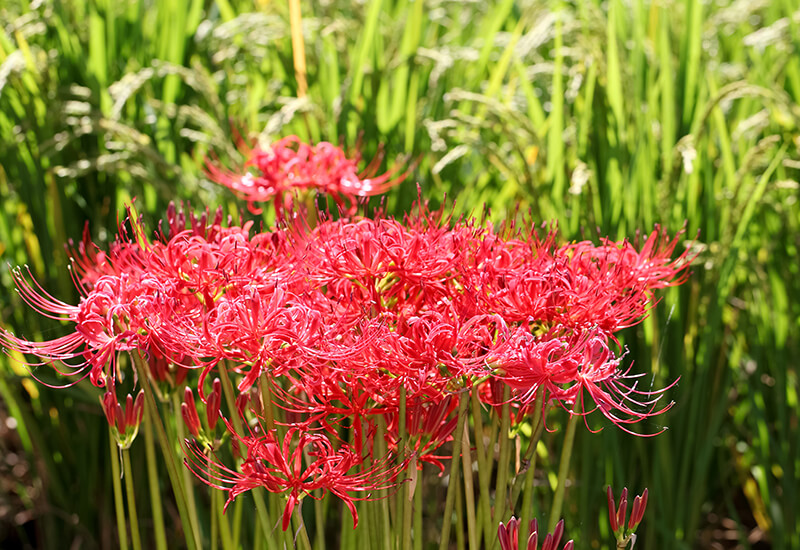
- 🔮 Symbolism: Bliss in the afterlife
- 💧 Water needs: Medium
- 🪴 Soil needs: Organically rich, well-draining
- 🌍 Growing zones: 6 to 10
- ☀️ Light needs: Full sun to part shade
- 🌱 Blooming season: August to September
Known in Japan as “flowers from heaven,” spider lilies provide eye-catching fall interest. You may have even seen images of these Japanese flowers appearing as crimson blankets across the landscape. Because they are bulb-based, you have complete control over where they will bloom. Use a straight line to emphasize a border or en masse to achieve the stunning carpet effect.
16. Japanese Flowering Cherry (Prunus ‘Kanzan’)
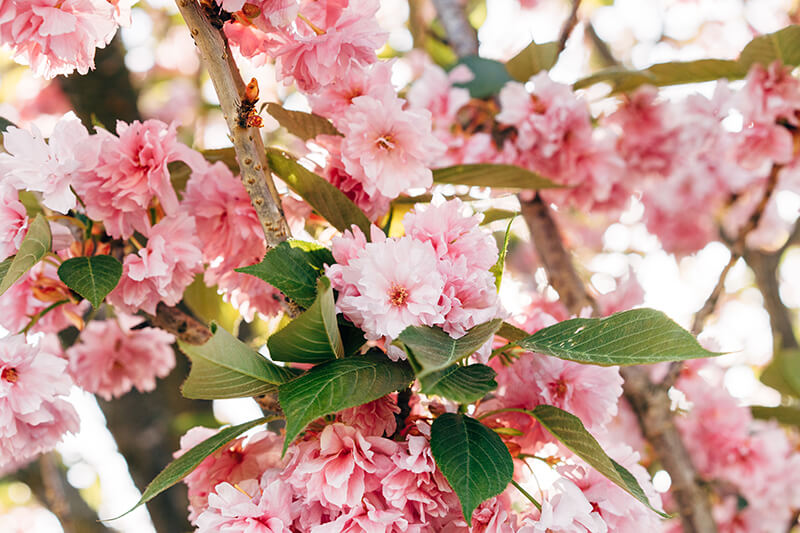
- 🔮 Symbolism: Life’s fragility
- 💧 Water needs: Medium
- 🪴 Soil needs: Fertile, well-draining
- 🌍 Growing zones: 5 to 9
- ☀️ Light needs: Full sun to part shade
- 🌱 Blooming season: April
When you think about pictures of Japanese flowers, cherry blossoms probably come to mind first. If you have space for an ornamental tree in your garden, you, too, can enjoy the ephemeral beauty found in cherry blossoms. This variety of flowering cherry blesses you with a feast of gorgeous double flowers in a rich pink hue.
17. Murasaki Shikibu Japanese Beautyberry (Callicarpa Japonica)
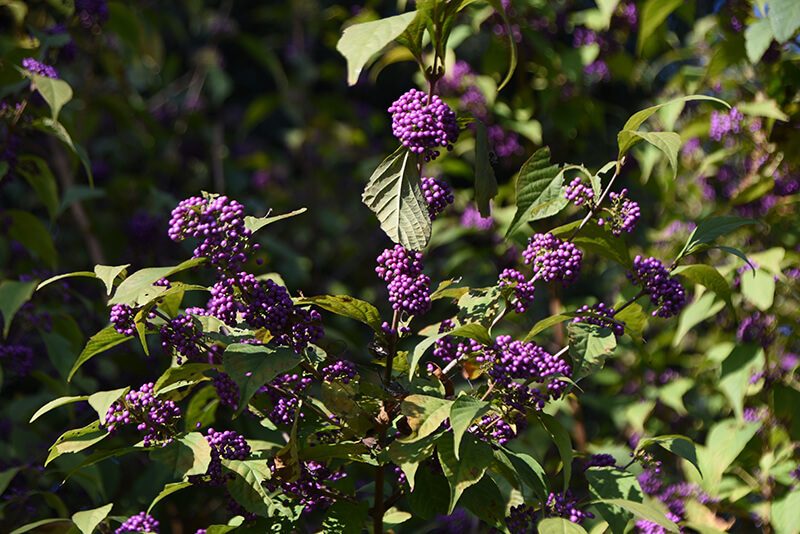
- 🔮 Symbolism: Love, loss, and elegance
- 💧 Water needs: Medium, drought tolerant
- 🪴 Soil needs: Average, well-draining soil
- 🌍 Growing zones: 5 to 8
- ☀️ Light needs: Full sun to part shade
- 🌱 Blooming season: June to July
Smooth purple berries symbolize love, loss, and elegance. With a name that translates simply to “purple,” beautyberries are named after an ancient Japanese story filled with romance and intrigue called “The Tale of Genji.” Selecting a Japanese beautyberry for your garden means that you will enjoy purple berries in a showy visual treat.
18. Roundleaf Chastetree (Vitex Rotundifolia)
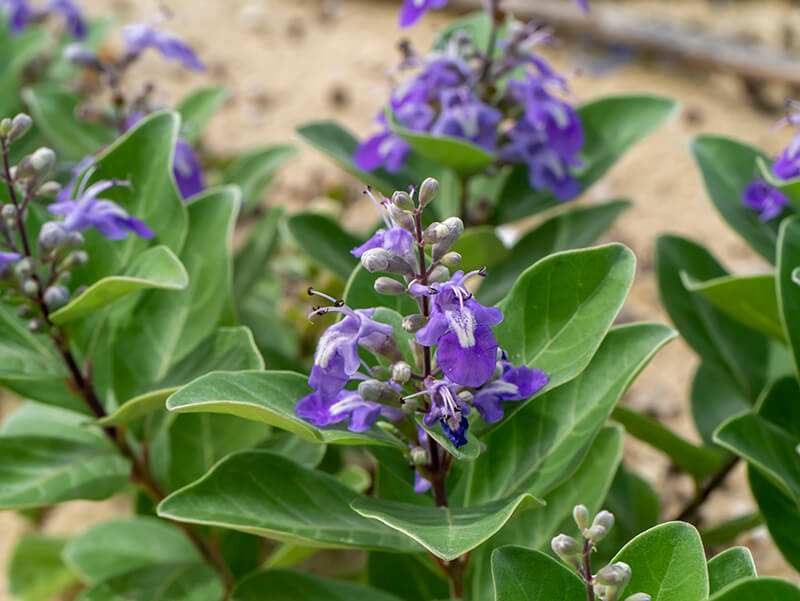
- 🔮 Symbolism: Innocent as a lamb
- 💧 Water needs: Medium
- 🪴 Soil needs: Loose, sandy, well-drained, tolerates poor soils
- 🌍 Growing zones: 7 to 10
- ☀️ Light needs: Full sun
- 🌱 Blooming season: May
As one of the many botanical species found in Setonaikai National Park in Japan, this coastal vine is ready to bring beach vibes to your garden. If your Japanese garden includes a pond, these intense purple flowers are a great way to add some ornamentation to bare sandy patches. However, in some environments, it can become invasive.
19. Mizubasho (Lysichiton Camtschatcensis)
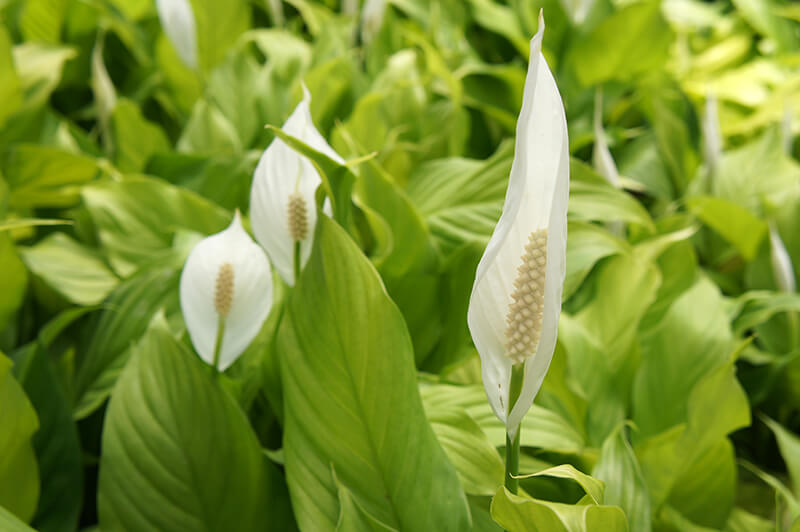
- 🔮 Symbolism: Concealed truth will become known
- 💧 Water needs: Medium to wet
- 🪴 Soil needs: Fertile, wet soil, tolerates flooding
- 🌍 Growing zones: 5 to 7
- ☀️ Light needs: Full sun to part Shade, tolerates full shade
- 🌱 Blooming season: April
Because Mizubasho is happiest when it is flooded, this is the perfect Japanese flower to plant next to a pond. To add some aquatic drama to your landscape, a 12-inch showy white hood cradles a spiky green spadix. As the flower fades, glossy green leaves take their place and continue to serve as a botanical feature.
20. Japanese Windflower (Anemone Hupehensis)
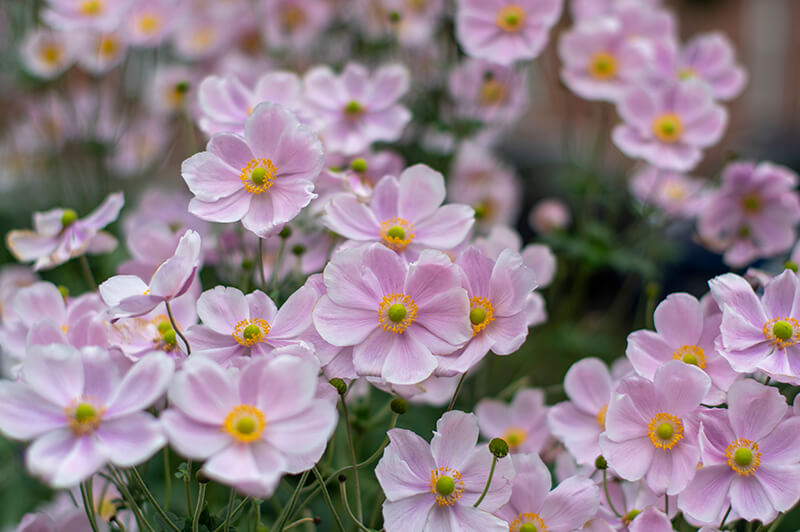
- 🔮 Symbolism: Constand motion, departure
- 💧 Water needs: Medium
- 🪴 Soil needs: Well-draining, alkaline, humus-rich soil
- 🌍 Growing zones: 4 to 8
- ☀️ Light needs: Full sun – part shade
- 🌱 Blooming season: August to September
Floppy pink petals and a generous button-like center can be enjoyed through summer until the first frosts. Maximize the effect by keeping the soil consistently moist and by planting in a cluster. If you live on the colder end of the Japanese windflower’s hardiness zone, you may want to mulch these flowers in winter.
21. Japanese Quince (Chaenomeles Japonica)
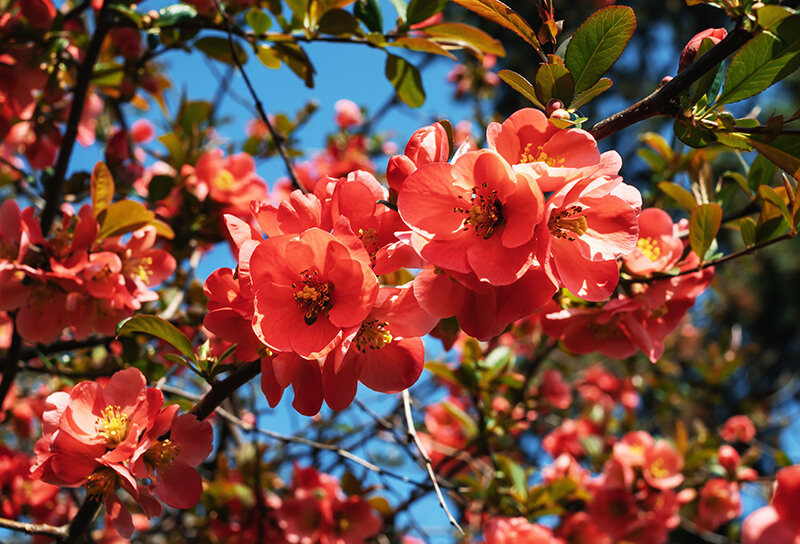
- 🔮 Symbolism: Temptation
- 💧 Water needs: Medium, tolerates mild drought
- 🪴 Soil needs: Average, well-draining soil, tolerates clay-type soils
- 🌍 Growing zones: 5 to 9
- ☀️ Light needs: Full sun to part shade
- 🌱 Blooming season: April
Although this shrub generally only reaches 3 feet in height, it generally grows to be 6 feet in length. Combined with showy scarlet flowers, this quality makes Japanese quince among the best types of Japanese flowers to act as a natural hedge. Surrendering to that temptation and inviting some Japanese quince into your garden feels sinfully good.
22. Japanese Witch Hazel (Hamamelis Japonica ‘Arborea’)
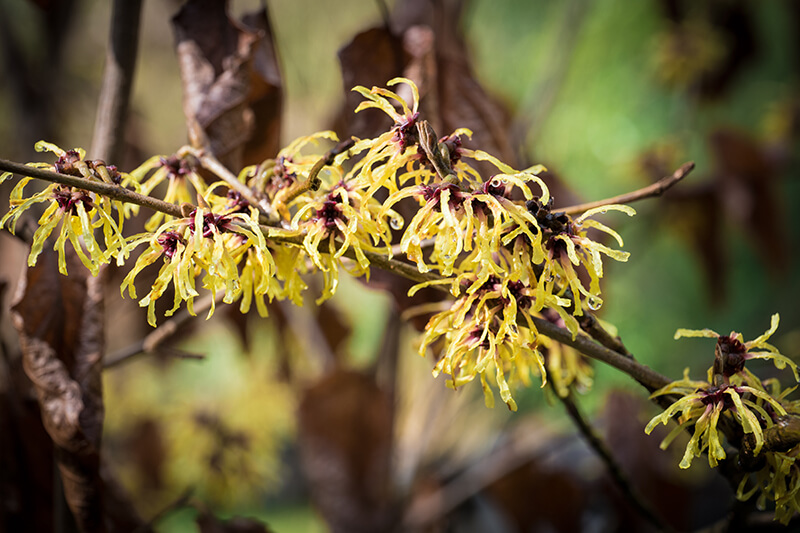
- 🔮 Symbolism: Bewitched
- 💧 Water needs: Medium
- 🪴 Soil needs: Average, acidic, well-draining soils, tolerates clay soil
- 🌍 Growing zones: 5 to 8
- ☀️ Light needs: Full Sun to part shade
- 🌱 Blooming season: February to March
Because Japanese witch hazel is native to majestic mountainsides, including one in your garden design means that you can capture some of that magic. Japanese witch hazel welcomes the first blush of spring with vibrant yellow streamer-shaped petals. As you plan your garden, be aware that this shrub can grow up to 16 feet tall.
23. Snowbell (Styrax Japonicus)
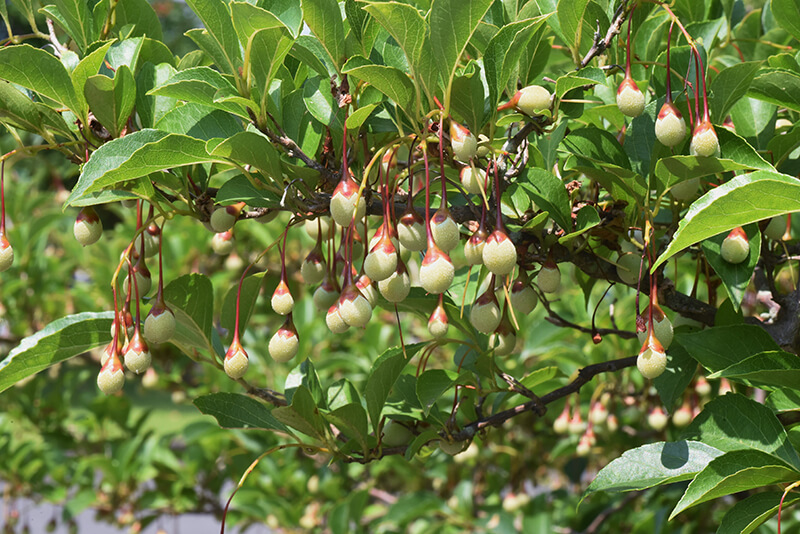
- 🔮 Symbolism: Snowballs
- 💧 Water needs: Medium
- 🪴 Soil needs: Acidic, well-draining soils
- 🌍 Growing zones: 5 to 9
- ☀️ Light needs: Full sun to part shade
- 🌱 Blooming season: May to June
Because its leaves are oriented upwards, the snowbell is one flowering tree that lets its full floral glory shine. In late spring and early summer, this 20-50 foot tall tree is covered in cascades of white blossoms. Before they fully bloom, it looks as if the snowbell is dripping with snowballs.
24. Kyushu Azalea (Rhododendron Kiusianum)
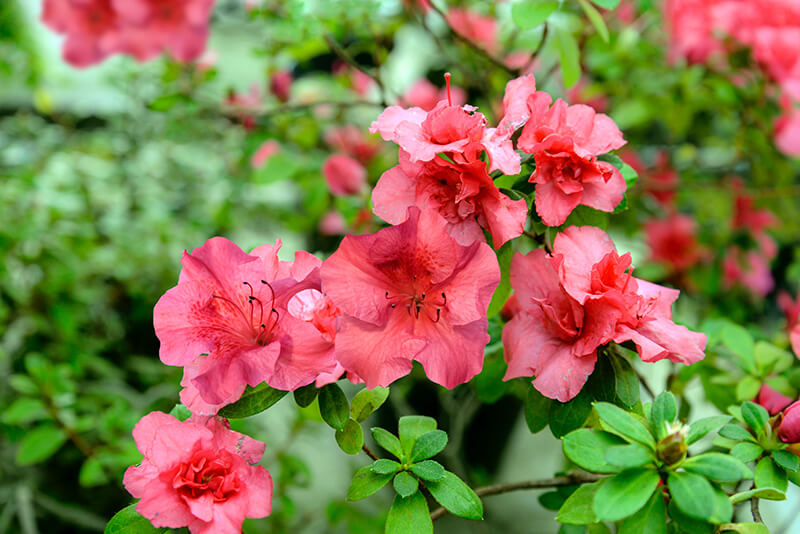
- 🔮 Symbolism: Fleeting beauty, evanescent passion
- 💧 Water needs: Medium
- 🪴 Soil needs: Porous, acidic, well-draining soil
- 🌍 Growing zones: 7
- ☀️ Light needs: Full sun
- 🌱 Blooming season: May
With intense color and stunning blooms, it is easy to see why the Kyushu azalea is the official flower of Nagasaki and Unzen as well as the Prefecture of Kagoshima. Because it is the parent of many varieties of azalea on the market today, you can have fun developing your own unique azalea variety.
25. Ajisai Hydrangea (Hydrangea Macrophylla)
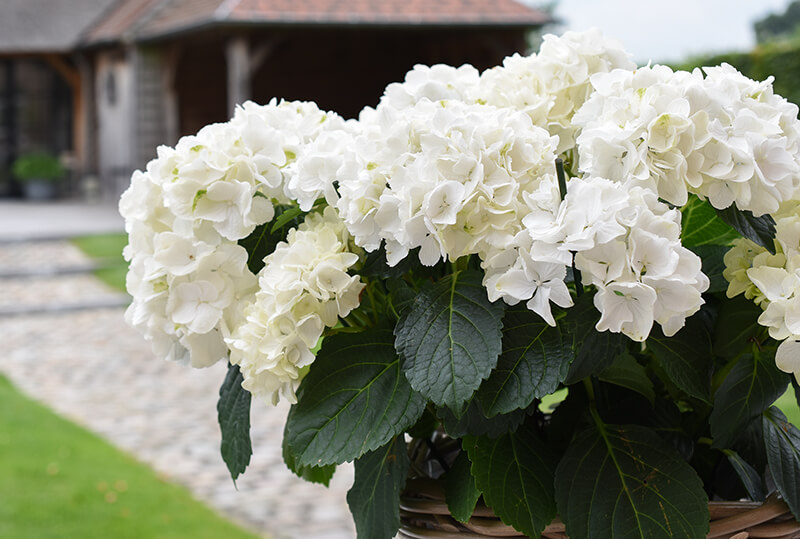
- 🔮 Symbolism: Self-satisfaction
- 💧 Water needs: Medium
- 🪴 Soil needs: Rich, well-draining soil, ph-factor determines flower color
- 🌍 Growing zones: 5 to 11
- ☀️ Light needs: Part shade to full shade
- 🌱 Blooming season: July to August
When you add a hydrangea to your landscape, you can delight in bounteous blooms all summer long. While this picture shows an enchanting shade of pink, you can amend your soil to achieve beautiful blue blossoms. Big flower clusters are the perfect way to celebrate a bounteous summer season.
26. Japanese Wisteria (Wisteria Floribunda ‘Multijuga’)
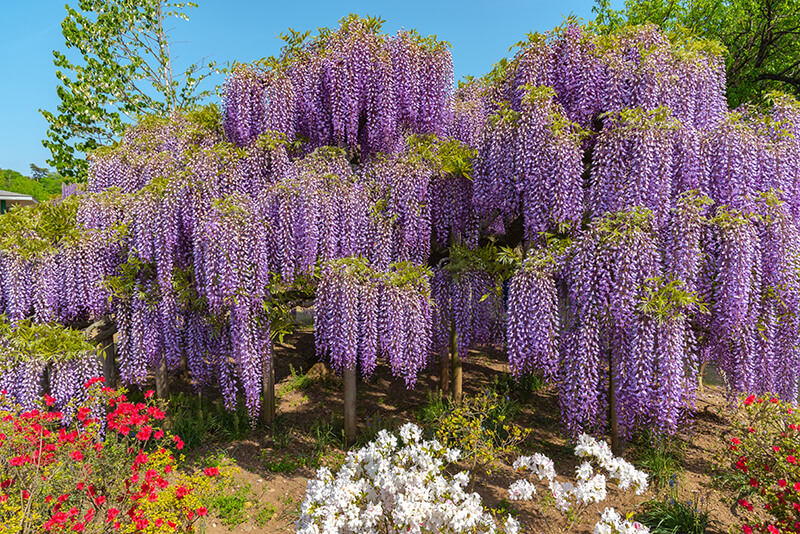
- 🔮 Symbolism: An embrace
- 💧 Water needs: Medium
- 🪴 Soil needs: Acidic, well-drained soil
- 🌍 Growing zones: 4 to 9
- ☀️ Light needs: Full sun
- 🌱 Blooming season: May
Characterized by violet cascades, this iconic flower offers plenty of picturesque appeal. Although it does require some maintenance and regular pruning, Japanese wisteria’s showy showers of blooms are worth the effort. These vining types of Japanese flowers will need something sturdy to act as a structure for their luscious abundance.
27. Yuki-no-shita Strawberry Begonia (Saxifraga Stolonifera)
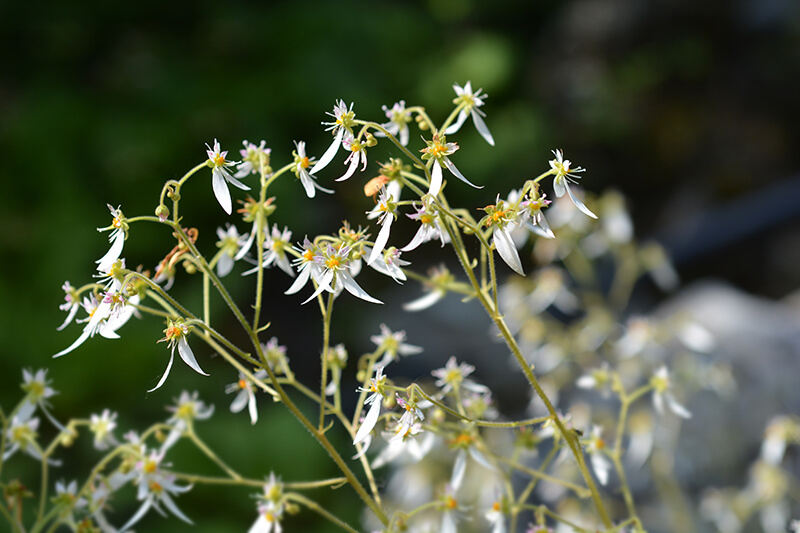
- 🔮 Symbolism: Snow
- 💧 Water needs: Medium
- 🪴 Soil needs: Light, well-draining soil
- 🌍 Growing zones: 6 to 9
- ☀️ Light needs: Part shade to full shade
- 🌱 Blooming season: May to June
Sometimes, asymmetry is more alluring than perfection. Two long lower petals counterbalance smaller top petals to offer a soothing ambiance. With a name that means “snow” in Japanese, white strawberry begonia flowers stand tall above geranium-like foliage. Because strawberry begonias spread quickly via runners, it makes an excellent groundcover for the shadowy sections of your garden.
27 Stunning Japanese Flowers to Plant to Achieve Inner Peace
As you design your landscape, do not be afraid to let your style shine. From mountain meadows to tropical beaches, Japan is a place full of magical settings and wondrous plants. Whether you are planning a full-scale Japanese landscape or just looking for exotic ways to spice up your garden, there are Japanese flowers right for both your setting and style.
Some of the flowers above offer a way to break out of your comfort zone and find new favorites. Others might be different varieties of familiar friends. Whichever types of Japanese flowers you decide to plant in your garden, focus on balance, discovering beauty in the imperfect, and self-discovery.

